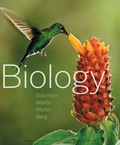
Concept explainers
The genetic description of an individual is its genotype, whereas the genetic description of a population is its (a)
Introduction: A gene can be referred to as a part of genetic material. They pass information from one generation to another. The genes contain DNA which decides the genotype of an individual. The genotype along with the geographical conditions determines the phenotype of an individual. The phenotype can be described as the physical appearance of an individual.
Answer to Problem 1TYU
Correct answer: Gene pool represents the genetic information of a population. Hence, the correct answer is option (b).
Explanation of Solution
Reason for the correct answer:
Gene pool of a population gives information about all the alleles for all the loci present in that population. It provides information about the genotypic description of the population by which phenotypic description of that population can be determined. The genetic variation among different populations can also be identified with the help of a gene pool. Therefore, gene pool gives the genetic description of a population.
Option (b) is given as “gene pool”.
Gene pool gives the information about all the alleles of all the loci in a population which represents the genetic description of a population. Hence, option (b) is correct.
Reasons for incorrect answers:
Option (a) is given as “phenotype”.
The phenotype of a population gives the information about the physical appearance of the individuals living in that population which does not represent the genetic description a population. Hence, option (a) is incorrect.
Option (c) is given as “genetic drift”.
Genetic drift can be described as a random change in the frequency of allele of a small population which does not represent the genetic description of the population. Hence, option (c) is incorrect.
Option (d) is given as “founder effect”.
The founder effect is also a genetic drift which occurs when a new area is colonized by a small population. Hence, option (d) is incorrect.
Option (e) is given as “changes in allele frequency”.
The change in allele frequency describes only about the genetic variation within the population, but do not give all the genetic description of a population. Hence, option (e) is incorrect.
Hence, options (a), (c), (d), and (e) are incorrect.
Gene pool represents the genetic description of a population.
Want to see more full solutions like this?
Chapter 19 Solutions
EBK BIOLOGY
- How is a protein destined for the Endoplasmic Reticulum (ER), imported into the ER? Be concise.arrow_forwardFind out about the organisations and the movements aimed at the conservation of our natural resources. Eg Chipko movement and Greenpeace. Make a project report on such an organisation.arrow_forwardWhat are biofertilizers and mention the significancearrow_forward
- PCBs and River Otters: Otters in Washington State’s Green-Duwamish River have high levels of polychlorinated biphenyls (PCBs) in their livers. PCBs can bind to the estrogen receptors in animals and disrupt the endocrine system of these otters. The PCBs seem to increase the estrogen to androgen ratio, skewing the ratio toward too much estrogen. How would increased estrogen affect the river otter population? Based on your reading of the materials in this unit, what factors can affect fertility in humans? Explain how each of the factors affecting human fertility that you described can disrupt the human endocrine system to affect reproduction.arrow_forwardOther than oil and alcohol, are there other liquids you could compare to water (that are liquid at room temperature)? How is water unique compared to these other liquids? What follow-up experiment would you like to do, and how would you relate it to your life?arrow_forwardSelection of Traits What adaptations do scavengers have for locating and feeding on prey? What adaptations do predators have for capturing and consuming prey?arrow_forward
- Competition Between Species What natural processes limit populations from growing too large? What are some resources organisms can compete over in their natural habitat?arrow_forwardSpecies Interactions Explain how predators, prey and scavengers interact. Explain whether predators and scavengers are necessary or beneficial for an ecosystem.arrow_forwardmagine that you are conducting research on fruit type and seed dispersal. You submitted a paper to a peer-reviewed journal that addresses the factors that impact fruit type and seed dispersal mechanisms in plants of Central America. The editor of the journal communicates that your paper may be published if you make ‘minor revisions’ to the document. Describe two characteristics that you would expect in seeds that are dispersed by the wind. Contrast this with what you would expect for seeds that are gathered, buried or eaten by animals, and explain why they are different. (Editor’s note: Providing this information in your discussion will help readers to consider the significance of the research).arrow_forward
 Concepts of BiologyBiologyISBN:9781938168116Author:Samantha Fowler, Rebecca Roush, James WisePublisher:OpenStax College
Concepts of BiologyBiologyISBN:9781938168116Author:Samantha Fowler, Rebecca Roush, James WisePublisher:OpenStax College Human Heredity: Principles and Issues (MindTap Co...BiologyISBN:9781305251052Author:Michael CummingsPublisher:Cengage Learning
Human Heredity: Principles and Issues (MindTap Co...BiologyISBN:9781305251052Author:Michael CummingsPublisher:Cengage Learning Biology (MindTap Course List)BiologyISBN:9781337392938Author:Eldra Solomon, Charles Martin, Diana W. Martin, Linda R. BergPublisher:Cengage Learning
Biology (MindTap Course List)BiologyISBN:9781337392938Author:Eldra Solomon, Charles Martin, Diana W. Martin, Linda R. BergPublisher:Cengage Learning
 Human Biology (MindTap Course List)BiologyISBN:9781305112100Author:Cecie Starr, Beverly McMillanPublisher:Cengage Learning
Human Biology (MindTap Course List)BiologyISBN:9781305112100Author:Cecie Starr, Beverly McMillanPublisher:Cengage Learning Biology Today and Tomorrow without Physiology (Mi...BiologyISBN:9781305117396Author:Cecie Starr, Christine Evers, Lisa StarrPublisher:Cengage Learning
Biology Today and Tomorrow without Physiology (Mi...BiologyISBN:9781305117396Author:Cecie Starr, Christine Evers, Lisa StarrPublisher:Cengage Learning





